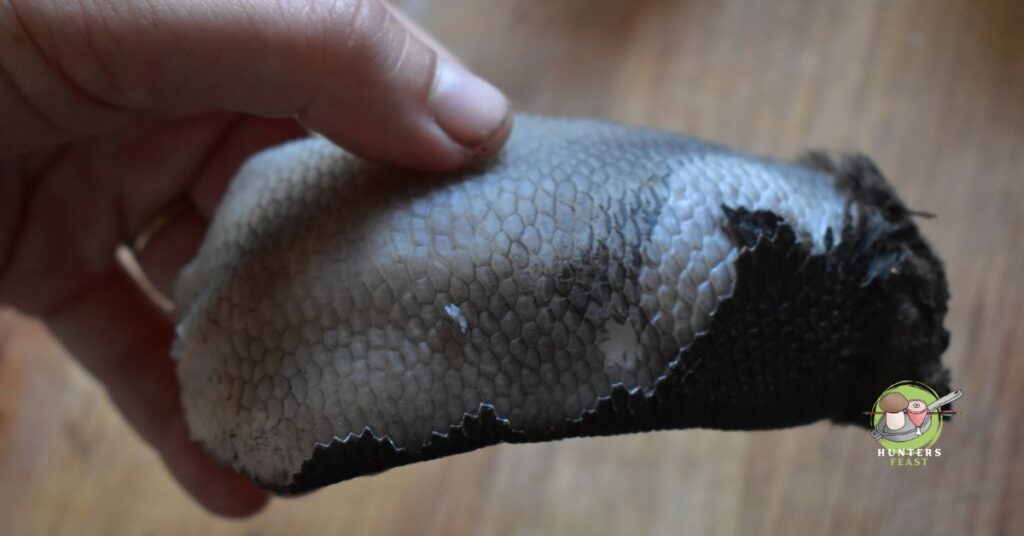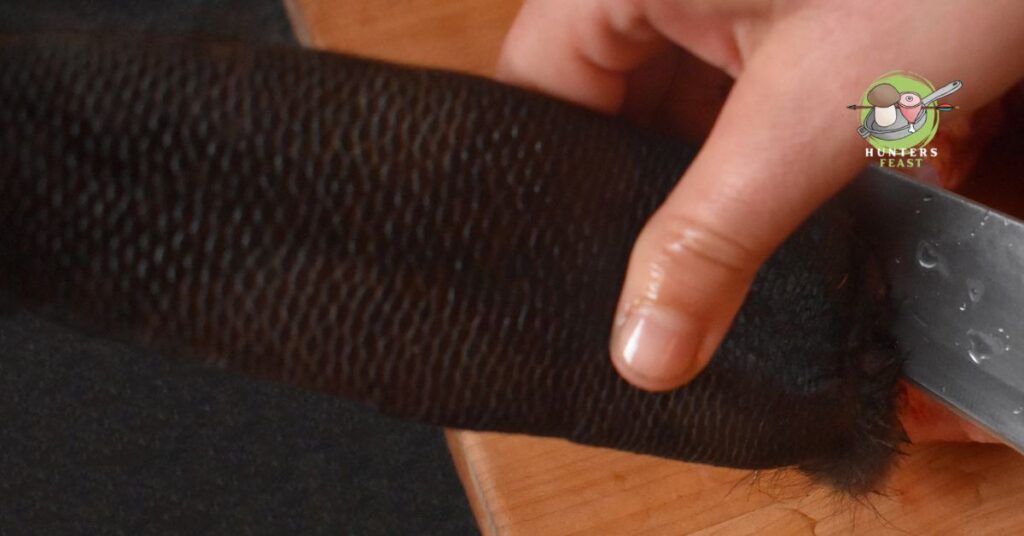Beaver meat is one of the healthiest meats one can get from the wild. Many trappers, wanting no waste, will eat the beaver after taking its pelt.
However, not many ever think about beaver tails. And we are not talking about deep-fried Canadian pastry.
The tail of a beaver is mostly fat, but it’s edible, just like the rest of the animal.
Can You Eat Beaver Tail?
Although it sounds exotic, the truth is you can eat beaver tail.
Some people, including hunters and trappers, would never touch it, but others claim it is something worth trying because of its unusual taste and texture.
Under the scally leather, the beaver tail is a bone with two small flaps of muscle on each side responsible for movement and fat – lots and lots of fat.
Beaver tail works as fat storage; hence in early winter, almost all beavers have bigger tails than in early spring.[1]
Similar to bear fat, this fat can be consumed after thermal processing.
History of Beaver Tail Eating
Eating beaver tails has a long history.
The exact beginning is not entirely known, but it is believed to have started with native tribes of North America and was carried on by trappers who went to the New World searching for fur since the early 16th century.
During the long and cold winters, trappers could only get the lean meat of animals they hunted and trapped.
Unfortunately, the nutrition they got from their meals wasn’t enough to sustain them during harsh weather and hard work.
Beavers were one of the most common trapped animals[2], so trappers had abundant beaver tails to eat. Many sources from the 1800s note the beaver tail as a part of the menu.[3][4][5][6][7]
Many modern mountain men are not very keen on eating beaver tails, but that may be because their diets are more varied.
After a long winter of lean meat, old-day trappers were craving fat compared to nutrient-rich diets available to hunters and trappers today, who see beaver tails only as a curiosity.
What Does Beaver Tail Taste Like?

I have eaten beaver tail only a handful of times, it’s not my favorite thing to eat.
Beaver tail taste is very mild. There might be a bit of fishy aftertaste, but that could depend on where the beaver lived.
Although it is made mostly from fat, it is not as greasy as other fats, such as beef fat. It is also not as rich in flavor.
In general, if you have ever tried lard, you will probably know what to expect from beaver tail taste.
The flavor is not rich, but the fat is rather heavy, similar to eating butter, but without the milky, buttery taste.
If left on the fire for long enough, it can taste a little bit like a weird combination of beef jerky and gristle.
To some, this may not sound too appealing. After all, a beaver’s tail is nothing but a lump of fat on a skinny bone.
Texture
Before cooking, the beaver tail is tough and springy. It makes you think it’s not even worth trying, but the magic happens during cooking.
Some people say that the beaver tail is tough and chewy, but a properly cooked beaver tail is anything but.
After thermal processing, the fat tissue becomes soft and melts if cooked too long.
The same case is with the beaver tail, and although there is still some connective tissue preventing it from melting completely, the beaver tail, after cooking, becomes soft like butter and dissolves easily in your mouth.
Is Beaver Tail Healthy To Eat?
Like most animal fats, there are good and bad sides to eating beaver tails.
The human body can’t produce essential fatty acids. Fat is also a source of energy and helps absorb vitamins A, D, E, and K. Beaver tails are full of saturated fat. In fact, per one serving of beaver tail, there is 32 g of fat.[8]
For a diet of 2000 calories, one should consume a maximum of 22 grams of this type of fat.[9]
It means that beaver tails can supplement our diets to a certain extent, as proven by mountain men and trappers of the old days.
However, consuming too many beaver tails when our bodies are already getting enough dietary fat intake may cause higher levels of LDL cholesterol, which can increase internal inflammation, plaque buildup, and even the risk of stroke or heart attack.
Can You Get Sick From Eating Beaver Tail?

According to the Government of Northwest Territories in Canada, beaver meat is very safe for consumption, including the beaver tail.[10]
The Giardiasis, commonly known as Beaver Fever, is transmitted only by feces, not through meat or fat tissue.
So, if you carefully dress the beaver without spilling its intestines, there is minimal risk of contamination.
The most common sickness from eating the beaver tail can be caused by eating too much, and as it is a relatively “heavy” dish, you can be sure you are not going to eat big amounts anyway.
How To Cook Beaver Tail?
The old-school method is the easiest way to cook beaver tail – directly over the fire.
After cutting the beaver tail off the carcass, you can put it on a grill or a metal crate over hot embers in the firepit.
Leave it for 10 minutes until the skin gets charred, and you can see the bubbles forming underneath. Flip it over, and wait 10 more minutes.
Take the beaver tail off and wait to cool slightly, then peel the skin off. Some people put it back over the embers for another 5 – 10 minutes, and others boil it for another 20.
However, the tail is ready to eat directly after peeling the charred skin off.
You can sprinkle it with some salt or other seasoning, as the fat would not have a lot of defined taste.
There is also a beaver fat lardo option, but it takes a little bit more time (2 – 3 weeks) in preparation before you can eat it.
Final Word
One can safely consume the beaver tail after cooking, and it was once considered a delicacy and necessity.
In modern times, the beaver tail is usually eaten by curious people and is perceived as an exotic dish – something to try once for the experience.
However, for some people, especially in the Canadian Northwest Territories, beaver meat and beaver tails are still consumed as a part of a diet.
The only downfall of the beaver tail is the amount of fat – one should carefully incorporate beaver tails into one’s diet due to the risk of increasing LDL cholesterol levels.
References:
- The Function of the Tail as a Fat Storage Depot in the Beaver (Castor canadensis)
- https://www.historycolorado.org/brief-history-fur-trade
- https://user.xmission.com/~drudy/mtman/html/ruxton.html
- https://user.xmission.com/~drudy/mtman/html/sage/rufussage.html
- http://user.xmission.com/~drudy/mtman/html/wislizenus/
- https://user.xmission.com/~drudy/mtman/html/nwythint.html
- https://user.xmission.com/~drudy/mtman/html/catlin/index.html
- https://www.hss.gov.nt.ca/sites/hss/files/traditional-food-fact-sheets.pdf
- https://my.clevelandclinic.org/health/articles/11208-fat-what-you-need-to-know
- https://www.hss.gov.nt.ca/sites/hss/files/resources/contaminants-fact-sheets-beaver.pdf










